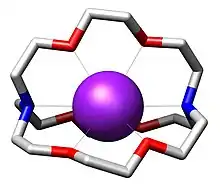2.2.2-Cryptand
Le 2.2.2-cryptand est l'un des membres les plus importants de la famille des cryptands, des chélateurs oligocycliques constitués d'au moins trois domaines complexants[3].

| 2.2.2-cryptand | |

| |
| Structure du 2.2.2-cryptand | |
| Identification | |
|---|---|
| Nom UICPA | 4,7,13,16,21,24-hexaoxa-1,10-diazabicyclo[8.8.8]hexacosane |
| Synonymes |
cryptand 222, cryptate 222, |
| No CAS | |
| No ECHA | 100.041.770 |
| No CE | 245-962-4 |
| No RTECS | MP4750000 |
| PubChem | 72801 |
| SMILES | |
| InChI | |
| Propriétés chimiques | |
| Formule | C18H36N2O6 [Isomères] |
| Masse molaire[1] | 376,488 2 ± 0,019 1 g/mol C 57,42 %, H 9,64 %, N 7,44 %, O 25,5 %, |
| Propriétés physiques | |
| T° fusion | 68 à 71 °C[2] |
| Précautions | |
| SGH[2] | |
 Attention |
|
| Unités du SI et CNTP, sauf indication contraire. | |
Notes et références
- Masse molaire calculée d’après « Atomic weights of the elements 2007 », sur www.chem.qmul.ac.uk.
- Fiche Sigma-Aldrich du composé 4,7,13,16,21,24-Hexaoxa-1,10-diazabicyclo[8.8.8hexacosane 98%], consultée le 4 octobre 2013.
- (en) « Cryptand », IUPAC, Compendium of Chemical Terminology [« Gold Book »], Oxford, Blackwell Scientific Publications, 1997, version corrigée en ligne : (2019-), 2e éd. (ISBN 0-9678550-9-8)
- (en) Roger Alberto, Kirstin Ortner, Nigel Wheatley, Roger Schibli et August P. Schubiger, « Synthesis and Properties of Boranocarbonate: A Convenient in Situ CO Source for the Aqueous Preparation of [99mTc(OH2)3(CO)3]+ », Journal of the American Chemical Society, vol. 123, no 13, , p. 3135–3136 (lire en ligne) DOI 10.1021/ja003932b
Cet article est issu de wikipedia. Text licence: CC BY-SA 4.0, Des conditions supplémentaires peuvent s’appliquer aux fichiers multimédias.